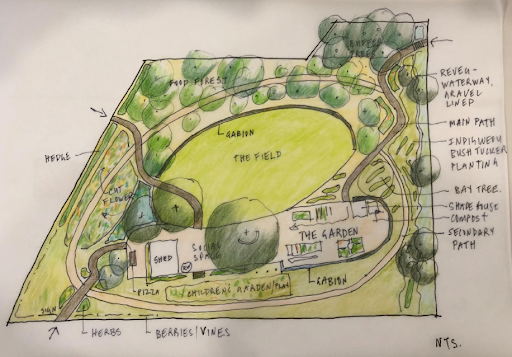Small town seeks to cultivate fruitful connections in the wake of disaster
The Australian town of Tallangatta knows a thing or two about change and resilience. Tallangatta, population 1,100, today sits on the edge of Lake Hume. In the 1950s, the entire town was relocated to its current spot, when the dam creating Lake Hume was elevated, flooding the town’s original location 4 miles away.
More recently, the town was one of many affected by wildfires that ravaged Australia in 2019-2020, when it served as a hub for relief efforts. The effects of an ongoing severe drought, and of course, a global pandemic, have continued to put a strain on residents.

The Tallangatta Community Garden working group at the project site.
To offer a place of respite for the town’s people and environment, the local health service set out to create a community park and garden that will integrate with the local ecology to provide food, beauty and a place for multigenerational learning. With help from Future Earth Australia in partnership with Thriving Earth Exchange, organizers are partnering with scientists to assess the site’s soil and inform a sustainable design for the garden.
“The purpose of the Tallangatta Community ‘Garden by the Lakeside’, is to bring together our local communities, after devastating bushfires and a global pandemic have kept us apart,” says Casey Fahey, project officer with Tallangatta Health Service, who serves as the effort’s project manager. “The community garden will help to share knowledge, experience and skills in relation to local food production and the mental and physical health benefits that this can provide, as well as provide a sustainable place of comfort and refuge for locals and travelers to meet or hold local community events.”
Whether you’re in the land down under or a hemisphere away, we think you’ll be fascinated by the insights from our recent conversation with Casey.
How would you describe your community to someone who’s never been there?
Tallangatta is a small rural farming town, primarily in dairy and meat, nestled in the hills and valleys of Northeast Victoria. The community of Tallangatta is one where most people know their neighbors, kids play freely around town, but if they play up, their parents will soon find out. It is a friendly environment where anyone is welcomed, and the town regularly comes together for public events and ceremonies.
What do you see as unique strengths of your community?
Tallangatta is made up of many local families [who] have been in the area for generations, as well as new families that have moved to the area for its friendly and supportive small-town environment. This has led to a strong community connectedness, and willingness of locals to constantly support each other in times of need. This was evident during the 2019-2020 bushfires that destroyed 60 homes in the wider region as well as burning 218,000 hectares [more than 840 square miles] of farms and forests.
Tallangatta is seeing a shift in some of the younger generations of families that are local to the area, in looking at what sustainable or alternate options there are for the region to make it an even more enjoyable and pleasant place to live.
What do you see as its unique challenges or struggles?
One of the hardest parts of this community is that we are all so widely dispersed, with the Towong Shire covering over 6,500 square kilometers [2,500 square miles]. This means that there is a need to travel to get to anywhere. There is no local public transport to allow the community to get around, except for school buses that bring the children in from around the region to the local schools. We have reasonable access to technology, but in our valleys, there is significant disruption to these services due to poor signals or long distances to telephone exchange for internet access.
What would you advise to others trying to tackle a community issue?

Site plan for the garden and park.
Allow a significant amount of time when undertaking community consultation in such a widely dispersed community. People want to be involved, but due to distance often you need to have multiple meetings to allow for everyone to be able to be involved. Also allow for nature. The weather has put a large dampener on our project, making for many community members [being] not willing or unable to travel out in poor weather, as well as hindering commencement and completion timeframes.
Utilize all available supports, both from local community/groups and wider supports. Getting outside input helps to put a fresh lens over a project, and also allows for consideration of things that may not have been thought of or overlooked in a small community. We have been fortunate to work with Future Earth Australia, who linked us with the University of Adelaide. The University has been able to provide us with both landscape design ideas created from our local community suggestions, and soil health advice to ensure that we create a sustainable and fruitful garden.
Learn more about Thriving Earth’s partners and collaborators. Check out our blog for more stories of tiny towns, wildfire-affected communities and going green with plants.
